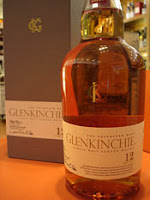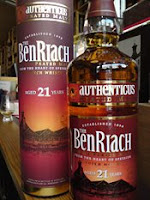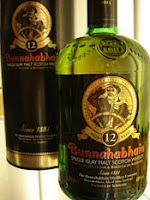 Caol Ila unpeated 8 years old
Caol Ila unpeated 8 years oldThis whisky is only produced for a very short time each year at Caol Ila distillery on the island of Islay. Normally, Caol Ila produce some of the smokiest whiskies in the world but this one is unpeated, young and fresh. This is bottled at a very high strength (64.2% ABV), is limited to only 5500 bottles and should cost between £40-45. The nose is full of crisp fruit (imagine green apples and pears), some citrus (like lemon zest), vanilla and malted barley. A gorgeous floral note (think of heather) emerges when water is added. The palate is intense yet light and creamy in the mouth with sweet vanilla and malted barley prominent. There is also some fruity citrusness going on (that zest again) and maybe a hint of saltiness. The finish is shortish and dry but full of flavour with that floral note coming through. This is an excellent whisky that is light, crisp and refreshing yet very complex. One of my three favourites of the night.
 Glen Elgin 16 years old
Glen Elgin 16 years oldGlen Elgin is one of Diageo's lesser known distilleries and the release from this Speyside distillery is the largest in the collection, with just under 10,000 bottles. It is bottled at 58.5% ABV and should cost between £50-60. The whisky has been matured in sherry casks and this shows in the colour and nose. The colour is dark amber and the nose is full of dried fruit (think of raisins and sultanas) and candied peel (imagine orange zest) with some butterscotch and vanilla. These translate on to the palate with loads of dried fruit and sweet vanilla. There is also a slightly acidic citrus note (orange zest again). These are joined by some sweet cereal grains and a hint of spice (think of nutmeg). The finish is medium and quite nutty (imagine almonds) with a bitter element coming through at the very end with some warm spices (nutmeg again). This is fairly pleasant but has too much sherry cask influence for my taste, making it slightly too bitter and woody. It is like drinking a strong version of a sherry.
 The Linkwood 26 year old range
The Linkwood 26 year old rangeThere are three very limited releases from this Speyside distillery. Each has had 12 years of maturation in a bourbon cask and then 14 years in either port, rum or red wine casks. Each expression has a release of only 1250 bottles and should cost around £130-150 each. The bottles are 50cl and were specially commissioned by an award winning designer. The port finish is bottled at 56.9% ABV and is almost crimson in colour. It has a rich and fruity nose that has red fruit as the predominant characteristic (think of blackcurrants, red grapes and blackberries). The palate is pretty sweet with that red fruit taking over, although some vanilla and an interesting citrus note (imagine orange zest) battle their way through. The finish in contrast is quite dry, bitter and tart. The rum finish is golden in colour and bottled at 54.5% ABV. There is a pleasant mix of notes on the nose, with citrus (think of orange zest), caramel, cereal grains and honey present. This is very sweet on the palate, almost sickly sweet. There are lots of sweet vanilla, those cereal grains again and some sugary cane sweetness. These notes follow through to the finish, which is fairly long but gets quite dry and bitter towards the end. The red wine expression is finished in a Burgundy wine cask and has a dark golden red colour. The nose hits you with loads of red fruit (imagine redcurrants, blackcurrants, blackberries and red grapes). There is lots of red wine character on the palate with the red fruit prominent. Some vanilla and butterscotch fight their way through but the over riding flavour is that of red wine. This dries your mouth and the finish is fairly long but very mouth drying and tannic. For me, these three expressions were disappointing. Linkwood is known as producing a light, aromatic spirit but here the distillery character has been completely overtaken and masked by the three finishes.
 Brora 25 years old
Brora 25 years oldWhisky from this closed highland distillery is becoming harder and harder to find. This bottling was distilled in 1983, the last year of production at Brora. Only 3000 bottles have been released and the strength is 56.3% ABV. A bottle should cost between £170-200. The nose is quite light with some smokiness (imagine wood ash), some citrus (think of lemon zest), dried fruits (like sultanas or raisins) and some nuttiness (imagine almonds). Upon adding water, the nose becomes more floral (think of heather) and salty (imagine seaweed or a sea breeze). On the palate, this is again light with a complex mixture of sweet vanilla, that citrus note from the nose, some malted barley and a salty tang. There is some smokiness but it is more subtle and earthier than the nose. The finish is reasonably long but quite dry with a bitter twist at the end. More smokiness and saltiness comes through than on the palate. This is good but left me slightly disappointed as it didn't quite seem to live up to the hype that Brora whiskies have.
 Port Ellen 29 years old
Port Ellen 29 years oldAnother bottling from a closed distillery, this time from Port Ellen on the island of Islay. The distillery stopped production in the early 1980s, although the maltings there still provided malted barley for some of the island's other distilleries. Stocks of Port Ellen are rare, especially at this age, and this is bottled at 55.3% ABV and limited to 6500 bottles. The cost should be between £180-200 per bottle. The colour is deep amber and the nose is elegant and rich. There is a sumptuous mix of sweet dried fruits (sultanas, i think), warm spices (think of nutmeg or cinammon), some saltiness (like sea air) and smoke (imagine coal fire smoke). On the palate, this is quite light and more subtle than many Islay malts. All the elements from the nose are present with the addition of a more peppery spiciness. The marriage of the coal smoke and salty brine-like flavours is really good. The finish is long and warm with that smoke and saltiness prominent, with licquorice and cinammon notes interestingly coming through at the end, especially when water is added. This is pretty good stuff and needs to be snapped up before it all runs out!
 Talisker 25 and 30 years old
Talisker 25 and 30 years oldThere are two releases from Talisker, the only distillery on the western island of Skye. Whilst the Talisker 10 years old is one of the best selling single malts in the world, whiskies of this age from the distillery are much rarer. The 25 years old was distilled in 1983 and has a release of 6700 bottles. It is bottled at 54.2% ABV and should cost between £130-150. The nose is surprisingly soft with some pepperiness (imagine black peppercorns), some saltiness (think of seaweed), caramel and a meaty smokiness (sounds weird but it instantly reminded me of smoky bacon crisps!). On the palate, this is pleasantly oily and quite thick. It is rich with some peppery smoke, some fruitiness (imagine dried fruit like sultanas), a hint of salt (think of brine) and an interesting iodine bitterness. The finish is long, warming and spicy (something like ginger?) with a more earthy smokiness. The 30 years old is gentler and more subtle than the 25. It is distilled in 1978 and is bottled at 49.5% ABV. There are only 3000 bottles released and one should cost between £200-230. The nose is very fresh for a whisky of this age and is a complex mix of dried fruit (think of Christmas pudding), saltiness (imagine seaweed) and subtle spicy smokiness (think of black pepper and nutmeg). This is thinner on the palate than the 25 with delicate sweetness marrying well with light smoke (imagine wood ash/embers), that salty element (think of brine) and the dried fruits (although these are less prominent than on the nose). The finish is long and quite herbal (menthol, maybe?) with some honey sweetness and just a whiff of smoke. Both of these whiskies are of excellent quality. If i had to choose one, it would be the 30 years old as it has so many subtle flavours and was different to any Talisker that i have tried before. One of my top three for the night.
 Lagavulin 12 years old
Lagavulin 12 years oldThis release from the iconic Lagavulin distillery on the island of Islay is one of the cheapest of the collection. At between £50-60, this is a real bargain. The colour is a gorgeous deep amber and the nose is full on. This has an intense nose full of peaty, earthy smokiness (reminded me of wood embers/ash) and this is joined by a lovely mix of caramel/toffee, some saltiness and a citrus element (imagine lemon zest). On the palate, this is full bodied with that smokiness marrying perfectly with some sweet barley, saltiness (think of brine), caramel and something nutty. With water, the whisky opens up to become even more smoky and salty with a pepperiness coming through. The finish is long and intense with that earthy, peaty smoke fading slowly. This is an excellent whisky and was probably my favourite of the evening.









